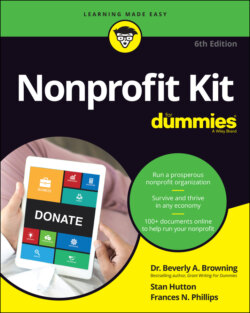Читать книгу Nonprofit Kit For Dummies - Stan Hutton, Beverly A. Browning - Страница 79
Conducting efficient meetings
ОглавлениеIf you’re looking for some tips to ensure effective board meetings, check out the following ideas:
Schedule a meeting between the executive director and board president before the meeting begins. This can be done in person or via phone, but it’s an important step in determining the agenda and the focus of the upcoming meeting. The meeting also allows the executive director to update the president on staff issues, funding opportunities, and any areas where the executive director needs particular guidance and support from the board.
Ten days to two weeks before a board meeting, send an announcement of the meeting to all board members. Include the minutes from the last meeting and an agenda for the upcoming meeting. Also include any committee reports, financial statements, or background research that the board will discuss at the meeting. If the meeting minutes include a list of tasks for board members to complete before the next meeting, try to send members a rough draft of the minutes as soon after the meeting as possible so that they can get started. (File 3-5 at
www.wiley.com/go/nonprofitkitfd6econtains an outline of meeting minutes that the board secretary can fill in during the meeting.)Limit the length of meetings to two hours or less, if possible. After two hours, especially if you’re holding the meeting in the evening, attention begins to wane. If you must go longer than two hours, take a break. Offering refreshments is always a good idea.
Try to find a conference room for the meeting. Holding a discussion around a conference table is much easier than sitting in someone’s living room. The table offers a place to set papers, and people won’t argue over who gets the recliner. It also sets the stage and implies that work is to be done. Avoid holding meetings in restaurants and cafes, if possible. The noise levels are too high to make good discussion possible, and all the activity is a constant distraction. You also have no privacy. Believe us — we’ve tried it!
Adhere to Robert’s Rules of Order. To adhere to proper board meeting protocol, follow these rules to conduct efficient, effective, and well-documented board meetings. You can download a copy of Robert’s Rules for free at
https://diphi.web.unc.edu/wp-content/uploads/sites/2645/2012/02/MSG-ROBERTS_RULES_CHEAT_SHEET.pdf, and check out Robert’s Rules For Dummies by C. Alan Jennings, PRP (Wiley).Stick to the agenda. Don’t allow people to wander off topic. Some agendas set the time allowed for discussion after each item. You don’t have to do this, but if your meetings have been veering off course, setting time limits may help control them. Files 3-6 and 3-7 at
www.wiley.com/go/nonprofitkitfd6eare samples of common agenda types you can use as models.Follow an orderly procedure. You don’t need to be overly formal in your meetings (many board meetings are casual), but having a basic knowledge of when to make a motion and when to call the question is helpful.
Thank your board. Board members are volunteers who give time and money to your organization. Take every opportunity during meetings to make sure they’re appreciated. Mention their names when appropriate in newsletters and media releases. Small gifts are sometimes useful, but don’t be extravagant. You don’t want to be accused of wasting the organization’s money.
